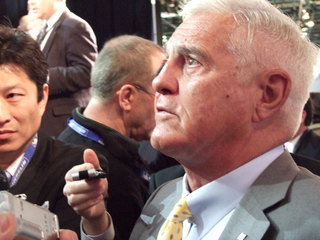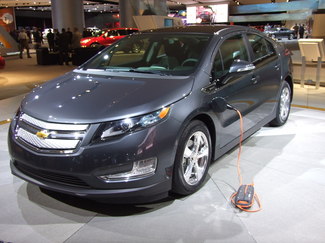GM's Bob Lutz: Weather will impact Chevy Volt's electric range
Jack Frost is no friend of the Chevrolet Volt.

GM Vice Chairman Bob Lutz said outside temperature will affect the performance of the Chevrolet Volt.
Nathan Bomey | AnnArbor.com
The Volt, General Motors’ much-anticipated extended-range electric vehicle to be released in November, won’t be able to travel the promised 40 miles on electricity in colder temperatures.
“The range can vary on any given day depending on temperature, terrain, driving conditions and so forth -- especially temperature,” GM Vice Chairman Bob Lutz told reporters this morning at the 2010 Detroit auto show. “Many people don’t understand that. The distance you can go in an electric vehicle varies hugely with the outside temperature, including with the Volt.”
GM has said the Chevy Volt will be able to travel an average of 40 miles on a single charge of electricity. After that, a gas engine kicks in and recharges the battery, which always drives the wheels.
But the battery’s charge won’t last quite as long in cold weather.
“If on a standard day you see 40 miles with the Volt, on a cold day where it’s right around 32 degrees, you’re going to see 28 or 30 miles,” Lutz said.
Nonetheless, GM is confident that the Volt is the right strategy. GM has invested more than $1 billion in the vehicle.
The automaker expects to produce 10,000 to 11,000 Volts in 2011 before ramping up to full production in 2012 with 50,000 to 60,000, Lutz said.
The Associated Press reported yesterday that GM would build a pure
electric version of the Volt by simply taking the internal combustion
engine out of the extended-range version.

GM's Chevrolet Volt, on display at the 2010 Detroit auto show, will be available in showrooms starting in November.
Nathan Bomey | AnnArbor.com
But Lutz today reiterated
that he believes extended-range electric vehicles are more viable
because drivers won't have to worry that their lithium-ion batteries will run out of
power.
"I frankly foresee a limited future for pure electric vehicles because the range is limited," Lutz said.
Volt engineers are still working feverishly to reduce the cost of the vehicle’s 400-pound lithium-ion battery pack, improve its durability and ensure its reliability. The Volt is likely to cost close to $40,000, although that will be offset by a $7,500 federal tax credit.
“The Volt has to be absolutely perfect and it’s got to perform exactly as advertised when it comes out,” Lutz said.
The vehicle is on track to hit showrooms in November 2010 - though Lutz said the program can’t be rushed:
We’re going to make a max effort to get some out into consumers’ hands in November. But it won’t be a significant quantity and it will be a quantity where we’re able to watch them very closely.
Because hey, this is a cake where the recipe calls for 45 minutes in a 375 (degree) oven. And you can’t just say, ‘We’re not going to do 45 minutes, we’re going to do 35 minutes.’ If you try to speed up a program like that, you’re doing it at your own peril. It means the cake is going to be half-baked. And we’re definitely not going to risk a half-baked cake with the Chevy Volt.
Contact AnnArbor.com’s Nathan Bomey at (734) 623-2587 or nathanbomey@annarbor.com. You can also follow him on Twitter.


Comments
domenico
Wed, Jan 13, 2010 : 4:02 p.m.
Dear Bob: You know better then to play the tree hugger's game. You were a pilot and you know mechanical technology when you see it. There is no device more efficient at transferring power from a carbon based fuel then a high tech Turbo supercharged positive displacement electronically controlled Diesel engine. There are too many power transmission losses from Nuclear, Oil, coal, Solar power generation to a battery ( electrical accumulator). I am sure that if GM put its considerable engineering staff to designing an engine just like the VW TDI you could come close. Going from internal combustion engines to any kind of stored energy is very difficult. Diesels are a known quantity. The plan should be a Diesel first, then a Diesel hybrid second. At least the Diesel will take you home on a dead battery.
Bob W
Wed, Jan 13, 2010 : 9:43 a.m.
This is a pretty expensive second car (second because I don't think many would buy one as the familie's one and only). Why are we subsidizing this to the tune of $7500 per car?? I personally have serious reservations. I guess we will have to wait and see.
bluemax79
Wed, Jan 13, 2010 : 8:32 a.m.
this car is a joke like all the things associated with the "global warming" farce that has been jammed down our throats by politicians.
John Galt
Tue, Jan 12, 2010 : 3:39 p.m.
This is a major problem with battery operated cars in a climate that is below freezing for several months of the year. Also, the comcept of power loss through moving the power from fossil fuel generators (coal, natural gas) that powers the majority of the electrical grid, overlooks the higher costs of step-up-and step-down power line loss. It will be more expensive to plug-in cars to charge on the homeowner electric bill. And it only moves the pollution from the car exhaust to the power plant smokestacks. A lot of smoke and mirrors with the concept.
John Hritz
Tue, Jan 12, 2010 : 1:42 p.m.
One small point: all vehicles (gas, diesel, electric, hybrids) experience seasonal variations in range due to temperature and differences in fuel formulation. If your Volt or other BEV/HEV is garage kept so that the batteries stay reasonably warm, you may see no reduction (at least on the out-bound leg of your trip).